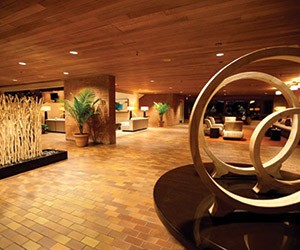It’s not surprising that in the second decade of the 21st century, technology is a prime driver in determining the kinds of features new and renovated hotels and conference centers are providing their guests.
Travelers, particularly meeting attendees, are equipped with an endless supply of electronic devices, ranging from smartphones to tablets and laptops. Consequently, they expect the properties they stay in to keep them optimally connected.
“Designing spaces that accommodate technology is more important today than ever before,” says Deborah Forrest, FASID, president of the hotel design firm ForrestPerkins. “And providing enough bandwidth to provide service to everyone attending a meeting or a conference is particularly important.”
Bandwidth is an issue that many hotels have struggled with in attempting to meet demand from leisure, business and meeting guests.
“It’s about speed now,” says Patrick Hatton, regional vice president of operations for the Denihan Hospitality Group, which recently opened the James Hotel in Miami Beach, Fla. Properties like the James, Hatton says, must provide whatever a meeting group needs without sacrificing services provided to individual travelers.
“In the past if we had a large group, we’d have to move bandwidth from the guest rooms to the meeting space, so the guest rooms would suffer,” he explains. “People simply won’t except that anymore, so you need high speed and the best technology. It’s a no-brainer.” PageBreak
Bandwidth was particularly important when it came to designing the Conrad New York, which opened last March. Its location in Lower Manhattan’s financial district makes it a destination for meetings and business travelers, “so the expectation of our customers is that they have to be connected at all times,” says Robert Rechtermann, the hotel’s general manager. “We had a conference here recently where we had 1,000 attendees and we provided Wi-Fi for as many as 600 users at any given time, so you need a vibrant Wi-Fi system in place to handle that kind of demand.”
Technology requirements go beyond simply meeting a group’s Internet requirements. As Forrest points out, hotel design has to allow for a sufficient number of conveniently located power outlets in—and outside of—meeting spaces to allow attendees to recharge the myriad numbers of electronic devices they’re carrying.
Flexibility and Experience
Whether designing a hotel from scratch or renovating an existing property, neutral, well-lit meeting spaces remain a priority, Skaife says.
“The decor needs to be beautiful, but still neutral, fresh and simple,” she says, adding that planners need to be able to go into a room and set it up according to their requirements. “You want to provide a relatively neutral backdrop to the event, because the event is the star, not the location.”
A key design concept for meetings is that of flexibility, according to Forrest. For example, she refers to the recent renovation at the Marriott Marquis Times Square in New York City. Her firm designed a flexible space in the hotel lobby that incorporate’s the lobby lounge, a three-meal restaurant and the Broadway Lounge “into fluid and dynamic spaces for cocktail events, media launches and privately sponsored functions within the larger conference.”
“Our clients consider every inch of space fair game for conference use,” she says. “Such flexibility maximizes revenue opportunities, and it keeps meeting planners happy as well.”
Skaife points out that when it comes to designing meeting areas—as well as adjoining spaces—it’s about making it an “effortless experience” for the attendee.
This means, for example, that meeting rooms should have adjacent breakout areas that attendees can retreat to in order to have a quick conversation with a colleague, answer a phone call or simply stretch their legs. PageBreak
Public spaces, such as lobbies, should also be meeting friendly. According to Forrest, lobbies should be able to accommodate a variety of groupings or activities, such as making phone calls, answering e-mails and networking.
Designers also have a mandate to provide productive, yet comfortable, work environments.
For Ace Conference Center in Lafayette Hill, Pa., an ongoing renovation of the property is designed to “foster a productive, comfortable and collaborative experience,” says General Manager Daniel Briones.
For example, the renovation of the meeting space will include a variety of models, including rooms that will contain lounge furnishings and ottomans with laptop tables, and others that will have high cafe tables, bar stools and rolling white boards.
“We’ve also included collaborative seating groupings in our guest room corridors and public spaces so that our meeting guests are able to ‘continue the conversation’ after leaving the conference area,” Briones says.
The Guest Room
The evolution of technology even plays a key role in guest room, as well as meeting space design.
“All guest rooms in conference hotels have to have Wi-Fi access, easily accessible electrical outlets for recharging, and a generous desk to allow attendees to keep up with their business responsibilities,” Forrest says.
Skaife has a different take on the continuing utility of the hotel room desk.
“Most people we talk to, when they need to work in a hotel room, sit on the bed with their feet up, with an iPad or a laptop on their knees, and the clicker to the TV next to them,” she says.
Rechtermann acknowledges that some still prefer to use a desk.
“But it’s no longer dominant,” she adds. “It needs to be incorporated beautifully into a room so it doesn’t just look like an unused desk.”
Hatton says the designers at the James went with a flexible, multiuse space rather than a traditional desk.
Michael Bassett is a frequent contributor to Meetings Focus.






